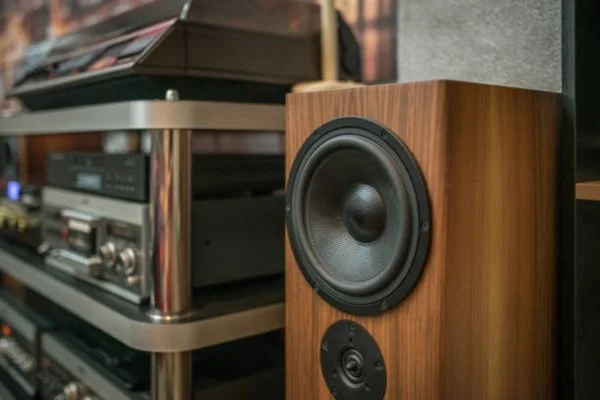Are you looking to upgrade your home audio system? You’ve come to the right place. Setting up a home stereo system can be intimidating. Still, with some knowledge and the right components, you can create an audio experience that will turn any room into your concert hall. Let’s look at what are the components of a home stereo system.
A typical home stereo system includes components like an amplifier, speakers, a CD or record player, a tuner, and source devices such as a smartphone or audio player.
Components of a Home Stereo System
Creating the ultimate home stereo system doesn’t have to be difficult if you know what components to look for. Generally, a home stereo system comprises four main components: an amplifier/receiver, speakers, the source device (like a CD/DVD player or turntable), and cables.
Amplifier/Receiver
The Amplifier/Receiver acts as the brains of your stereo system. It takes the audio signal from your music source, amplifies it so that it can be heard through speakers at audible levels and then sends it out to the speakers.
Without an amplifier or receiver, you wouldn’t hear any sound from your home stereo system, no matter how great you think the speaker sounds are! When selecting an amplifier, one important thing to consider is the power output per channel; this will tell you how much power each speaker receives.
Most amplifiers range from 20W-200W per channel, which is suitable for different size rooms with varying loudness requirements. If you need average volume in a medium-sized room, something around 40-60 watts per channel should do just fine!
Also Read: How To Setup A Wireless Home Stereo System?
Speakers
The Speakers make up most of the sound quality of your home audio system — without them, nothing would come out of your listening experience! The kind of speakers you purchase depends on what type of listening experience you’re after, and how large (or small) a space they’ll inhabit informs their ideal size and shape too!
For example, if space is tight, bookshelf speakers may be best due to their smaller footprint — though standing floor loudspeakers provide better low-frequency detail due to increased cabinet area, which helps produce higher output signals at lower frequencies with less distortion than smaller models can achieve.
If vinyl records set off bells in your head, then turntables may also factor into constructing a comprehensive audio setup; if not now, maybe down the line, maybe?!
They still offer superior sonic performance compared to digital media players playing classic recordings. They can process many signal inputs like cassette tapes, which some modern devices don’t support– all without compromising sound fidelity either… Win-win right?
Cables
Lastly, Cables serve as conduits between components to communicate effectively…sometimes forgotten about but essential nonetheless! In terms of choice, there are quite a few options, such as RCA interconnects running preamp outputs over long runs.
Shielded twisted pair cables transferring line level signals between separates – banana plugs terminated speaker cable furnishing power drive into loudspeakers, etcetera.
As always, careful consideration must be taken both aesthetically & technically when opting for cabling materials – check out specialist retailers’ lists online based on various criteria & specifications that suit best before investing in anything more major investments like this one.
Also Read: How To Add Bluetooth To Your Home Stereo System?
How do Stereo Systems Work?

Stereo systems are an impressive and complex technology that utilizes sophisticated components and processes to produce a listening experience.
The basic premise of stereo sound is that it engages both ears, creating a rich, immersive soundscape with greater depth than single-speaker audio systems can provide.
The most common type of stereo system consists of two speakers (“left” & “right”) plus an amplifier/receiver for functions such as playing music from your library or streaming services like Spotify.
Every speaker has its dedicated input channel on the amp/receiver, allowing each one to process the left and right signals separately – this allows for nuances in the track, such as panning effects or adjusting the relative volume levels between channels.
Once connected up, your amp/receiver will take whatever audio signal it receives (whether it’s coming from your phone via Bluetooth or from a CD player).
And use its built-in preamp circuit(s) to increase the level before sending it out over internal amplification circuitry onto its respective speaker channels.
This is where each channel’s quality control occurs; most amps have multiple output stages that allow further adjustments based on desired frequency response (bass vs. treble balance).
Finally, all this comes together when you sit back in front of your speakers – they play out those low-frequency notes via woofers tuned just right while airy high frequencies get bounced off their tweeters directly into your ear’s hearing range – creating a 3D sound experience unlike any other!
Also Read: How To Install A Home Stereo System?
Bottom Line:
No you know what are the components of a home stereo system. Setting up a home stereo system can seem overwhelming at first. Still, with some basic knowledge about each component and how they work together, you can create an amazing listening experience quickly!
With the right combination of amplifier/receiver, speakers, and sources for your music—you’ll be ready for hours upon hours of Hi-Fi listening pleasure! Intended Audience: Homeowners looking to upgrade their existing home stereo systems

